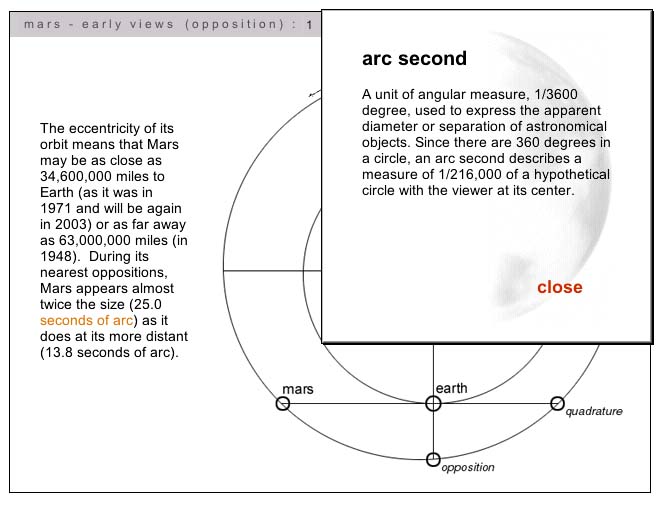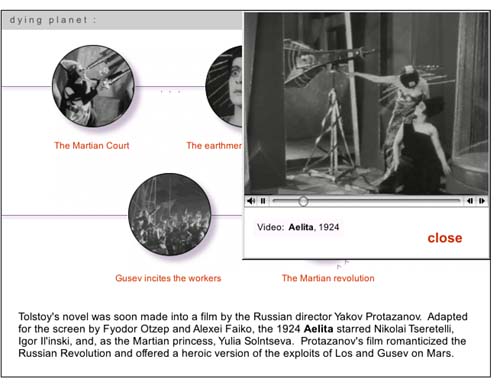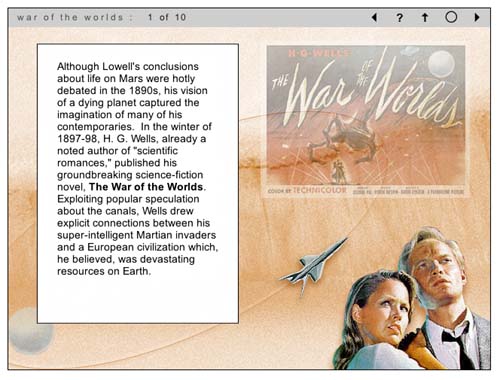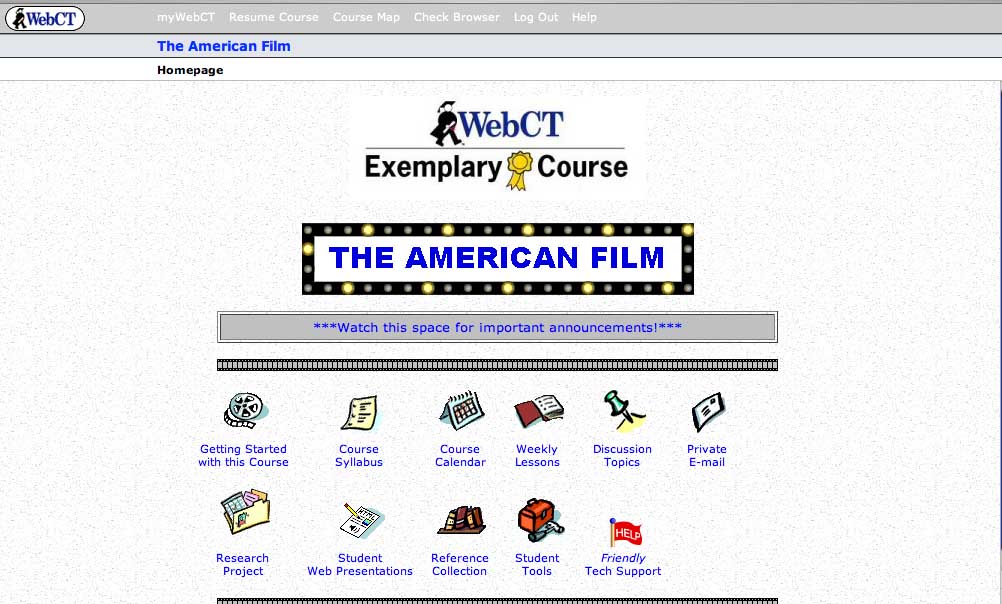January 6, 2006
Narrative Structure and Medium: "The Red Planet" and the Future of the Educational DVD-ROM

As we've noted before in Next/Text, a key question in considering the future of the digital textbook is whether the text should be delivered to the user via the web or on a disc. In the 1990s -- when Voyage pioneered the development of the educational CD-ROM -- the choice was clear: accessing video and audio was far too difficult to make developing web content worthwhile.
Since the demise of Voyager, however, the production of disc-based educational material has gradually decreased, and it has become less clear that ROM discs are the medium of choice for delivering "thick" multimedia content. As some of the examples we've written about (especially the WebCT film course and the MIT Biology class) demonstrate, streaming video can be easily integrated into online instructional material: there's still much room for improvement, but it's clear that online video and audio delivery will only improve over time.
So what is the future of the disc-based educational text? The question seems especially relevant now that the recent industry debate over the formats of next-generation DVDs has provoked more than a few technology analysts to wonder aloud whether discs themselves are a doomed delivery medium. I'm not completely convinced by these arguments, as I feel that, as far as educational media are concerned, there may still be good reasons to put things on disc. In what follows, I'll be weighing the pros and cons of scholarly work on DVD-ROM through a discussion of The Red Planet, a DVD-ROM project published in 2001 by the University of Pennsylvania Press.
The Red Planet is the first publication in Penn's Mariner 10 Series, a publishing venture that represents the first attempt by a university press to publish scholarly work on DVD-ROM. The titles chosen for this Penn series are interdisciplinary studies that blend what C.P. Snow might call the "two cultures" of science and the humanities; each also includes a wide range of textual, visual and audio resources. Thus far, in addition to The Red Planet, Penn has published a volume on humanistic approaches to medicine; a physics text, "The Gravity Project," is forthcoming.
Interestingly, The Red Planet has its roots in an unsuccesful venture in online education: project co-author Robert Markely was first approached to do a series of video interviews to be embedded in a web course about science fiction. When that project fell through in 1997, Markley realized that such interviews would be an ideal first step towards creating a digital scholarly text that explored the roles Mars has played in 19th and 20th century astronomy, literature and speculative thought. Teaming up with multimedia designer/theorists Helen Burgess (also a co-author for Biofutures, a DVD-ROM-in-progress that I've previously discussed) Harrison Higgs and Michele Kendrick, Markley approached Penn with his idea for the project.
After getting the go-ahead from Penn -- and substantial funding from West Virgina University and Washington State University -- the group spent more than four years completing the project. Markley wrote a 200-page monograph on cultural and scientific approaches to Mars divided into nine chapters -- Early Views; The Canals of Mars; The War of the Worlds; Dying Planet; Red and Dead; Missions to Mars; Ancient Floods; Dreams of Terraforming, and Life On Mars. He and others in the group in the group then interviewed science fiction writers including Kim Stanley Robinson, cultural critics such as N. Katherine Hayles and a diverse group of major scientific figures including Richard Zare, Carol Stoker, Christopher McKay and Henry Giclas (the Giclas interview is pictured below). They also assembled hundreds of current and archival photos, quotations from scientific and literary texts, dozens of clips from science fiction films, and an impressive array of diagrams explaining key concepts in astronomy. And to complement the DVD-ROM project, they authored a website with educational resources, a timeline, and updatable discussions of debates about Mars exploration.

The success of The Red Planet stems from the fact that all of this multimedia does not serve simply to gloss on Markley's monograph: it changes Markley's own authoring process as well. As Markely points out in a chapter he wrote on the project for a book titled Eloquent Images, his main challenge was to create a work that was scholarly enough to be considered worthy by tenure committees, a requirement that has been a serious hurdle to the willingness of academics to invest time and effort in the creation of digital scholarly work. "The majority of commercial educational software treats content as a given," Markley wrote, "reified as information that has to be encoded within a programming language and designed in such a way as to enhance its usuability." To Markley, moving beyond this "usable information" paradigm, involved more than just foregrounding the text: it meant that the designers should make a significant contribution to the intellectual shape of the project that extended beyond usability issues and promoted them to the status of co-authors.
With this in mind, Markley and his co-authors worked collaboratively to develop a navigation structure for the project that reflected both scholarly and pedagogical concerns. The resulting interface eschews the hypertext structures of many web-based projects and relies instead on a chronological narrative structure that the authors felt best maintained the integrity of the scholarly text. In other words, hyperlinks don't move the user around inside the central text, but rather lead to film clips or selections of explanatory material (such as the diagram illustrating the term 'arc second,' pictured below).
The structure of The Red Planet thus resembles, in some ways, the structure of Columbia University's Gutenberg-e publications: if the reader chooses, they can read straight through the text and ignore the linked explanations and supporting material. For the most part, video interviews open on seperate pages and launch automatically (the screenshot above actually shows an exception to this), but the reader can always use the forward navigation key to advance the narrative.

The Red Planet demonstrates that this text-centric approach to digital scholarly work need not come at the expense of the quality of multimedia integrated into the project. From the beginning, Markley and his collaborators wanted The Red Planet to be a standout in terms of both the amount and the quality of supporting media. This, in turn, determined their choice of medium: in writing grant proposals to fund the development of the project, Markley stressed the importance of using DVD-ROM instead of CD-ROM to construct the volume. At the time The Red Planet was produced, the disc was able to hold about six times more data than a traditional CD-ROM; it was also able to read this data about seven times faster, meaning that the video segments played much more smoothly and were of far higher quality. As Markely wrote in his chapter for Eloquent Images, "video on CD-ROM is a pixilated, impressionistic oddity: on DVD-ROM, video begins to achieve something of the semiotic verisimilitude we associate with film."
The DVD-ROM format also allows The Red Planet'sdesigners to incorporate much longer video clips into their project: interviews are up to five minutes in length, and video clips are the maximum length allowable under fair use. In the case of the interviews, the longer interviews allow for detailed explorations of the question at hand: in the case of the film clips, the expansiveness of the selections gives the viewer a sense that they are experiencing a portion of the actual film rather than a snapshot.

Still, though the videos are high quality, they are not full screen (as shown by the screenshot above, which shows a page that features a series of clips from the 1924 Russian film Aelita). The limited size of the clips is one of a series of tradeoffs Markley and his team found they had to make when confronted with their own limited budgets and realistic pricing expectations for their DVD-ROM. In his chapter for Eloquent Images, Markley writes:
In authoring The Red Planet, we were caught in an ongoing process of having to decide what we could afford in time, money and labor to live up to our grant application claims that DVD ROM could do what neither CD Rom nor the web could manage: integrate hours of high-quality video into a scholarly multimedia project. At the same time, we had to engineer downward the minimum requirements of RAM, operating systems, monitor resolutions, etc to avoid pricing our project out of the mainstream educational market.
Markley's point is an important one: DVD-ROMs have the potential to deliver amazing multimedia content, but that is simply the capacity of the medium. A successful DVD-ROM author not only has to find the time, money, and skill to produce the project; they also have to operate within the constraints of a market which is increasingly accustomed to getting educational content online for free. In the end, The Red Planet was probably more successful at the former than the latter: as a example of the genre, it is exceptional both in content and design, yet the disc has yet to find the wide audience of both scholars and Mars enthusiasts that its authors had hoped it would find.
Looking at The Red Planet and reading Markley's theorization of the work done by his team, I'm impressed by their very self-reflective effort to author a major project over several years in the midst of a rapidly shifting new media landscape. I'm convinced by Markley's argument claims in Eloquent Images that the DVD-ROM format allows multimedia authors to create projects that are more narrative-centered, and thus also, perhaps, more scholarly and more acceptable to the legitimating bodies of academia. At the same time, I'm unsure what will happen to the market for such work: either we will see a critical mass of DVD-ROMS emerge that will create a critical mass of reader/users, or the format will atrophy as the web becomes more and more the preferred method of distribution. Markley himself is aware of the uncertain future of projects such as his own: while making the case for The Red Planet as the best fit between form, content and medium, he also notes that the project is less "a model to be emulated" as much as it is "a historical document, a means to think through the scholarly and professional legitimation of video and visual information."
So should scholars persist in authoring in the medium? I think so, as long as they take a clear-eyed view of its advantages and pitfalls, and as long as they realize -- as Markley and his team did all along -- that while the time and effort spent on a DVD-ROM project is greater than the time spent on a traditional academic monograph, the audience might ultimately be more limited. Not always: a project such as the Biofutures DVD (discussed in an earlier post), which has been developed with a very specific pedagogical aim, might find a more extensive academic audience even if it doesn't find a non-academic one. The same might be said for Medicine and Humanistic Understanding, the newest title in the Mariner 10 series. The key is finding a way to create a new media object that is stable enough to allow users to take advantages of its merits both now and in the foreseeable future.

Posted by lisa lynch at 2:37 PM
December 29, 2005
"The American Film" -- Using WebCT To Author Digital Texts

Over the past few years, more and more professors have begun using course management software such as WebCT or Blackboard (and, increasingly, the non-commercial and open-source Sakai) to organize their syllabi, place assignments online, and create online forums for class discussion. In some cases, WebCT courses are designed so comprehensively that they come to resemble digital course texts, including a substantial amount of original pedagogical material. One example of this is The American Film, a course taught by Thomas Valasek at Raritan Valley Community College that has been recognized this year as an Exemplary Course by in an annual WebCT competition (a description of the class and guest access are available here through the WebCT site).
Valasek, who uses WebCT as a distance-learning platform, has incorporated his own lectures and film analyses into the site, and included relevant film clips which are annotated by his own voiceover narration. This means that students are able to access unique content through the site, instead of using WebCT merely as a portal to download information authored elsewhere. It also means that Valasek has managed to create an online-only film course that give students the feeling of being present when the professor is walking them through scenes of a film -- perhaps the most important part of a lecture-based film class.
The American Film introduces students to American cinema through a discussion of the narrative and visual style of Hollywood movies. After a section on the culture of Hollywood (centered around the film The Player), and on narrative and visual style in film (centered respectively on American Beauty and On The Waterfront), Valasek focuses on four popular film genres: romantic comedy, the western, science fiction, and film noir. Students are expected to watch a series of films on their own and to use the lectures and discussions on the course site as a launching point for their own research projects. In each case, Valasek pairs a classic example of the genre with a contemporary adaptation, with the expectation that students might be able to draw on their familiarity with the more recent film to help with their interpretations of the older work.

An example of Valasek's voiceover work can be found in his discussion of the crucial scene from On The Waterfront when the priest Father Barry tries to convince Terry Malloy, the films protagonist, to confess to his fiancee that he had helped organize a mob hit on his own brother. As the clip plays, Valasek's narration asks us to pay attention the metaphorical use of a high metal fence in the background: "Terry is fenced in here; he's unable to decide what he wants to do and what the right thing to do is. We can see that the fence has him cornered in the shot, but also emotionally he is fenced in."
As the scene shifts, Valasek continues to describe in detail both the visual and aural techniques used by Kazan to convey emotional intensity, making sure that his voiceover keeps pace with the film itself:
The scene is set up as a long shot behind a pile of rubble, and we see the two characters face-to-face. But as soon as we get into it, the action is going to cut much closer. We're going to see, in fact, a series of alternating close-ups of their two faces getting closer and closer on them until we finally see Edie's face in extreme close-up, her white gloves covering her mouth and her eyes trying to take in the shock of what Terry is trying to tell her...The point of the scene here is to show us the emotional reaction of the characters as he confesses to Edie. And to that purpose, the sound track is what's really driving the scene. The pile driver's hammering away at us; the noises are building up in intensity, covering over their words, drowning out everything that they say, but adding this powerful emotional overlay to the scene.
Valasek's clips are about three minutes long -- ample, but still within the boudaries of fair use -- and students can choose to watch them with or without Valesek's voiceovers. They can also read the transcripts of Valasek's comments seperately from watching the clip.

Additional features of the site include a hyperlinked glossary of film terms (pictured above), linked assignments, and an online forum in which students analyze the films they watch -- a necessary addition, since class discussion takes place entirely online.
At present, the primary limitations of The American Film seem to be those of WebCT itself. As a piece of software, WebCT is designed more for efficacy than elegance, and the clunky interface can be headache-producing: it's also the case that students who have all of their classes on the platform sometimes experience "WebCT blur," the feeling that all of their courses are seeping together. Of course, Valasek could move past these limitations by developing the multimedia content on this site even further; instead of embedding it in a WebCT platform, he could potentially create a DVD with his film analyses and discussion for broader use as an introductory film text. I'm curious as to whether anyone working in WebCT has considered the fact that they, like Valasek, are already well on the way to producing a digital textbook. Now that such labor-intensive multimedia learning objects are being created with increasingly frequency for course-specific situations, there needs to be more conversation about how to "free" such scholarly effort for broader academic use.
Posted by lisa lynch at 1:24 PM
November 22, 2005
"Binding Memories" on Gutenberg-E

After receiving a Mellon grant in 1999, Columbia University Press began awarding $20,000 "Gutenberg-e" awards to scholars with outstanding history dissertations, in order to help these scholars revise their books into digital texts. So far, twelve of these digital books have been published on the Gutenberg-e site, and sixteen more are slated for publication: this makes Columbia University Press the most significantly player the e-publishing field to date. Currently, the texts can be read for free as part of a limited-time free trial offer; for $49.50, one can purchase unlimited online access to a single text and also download it as a PDF file.
Columbia and the Mellon Foundation must be commended for their efforts to move academic publishing into a perhaps more economically viable online environment: at the same time, the e-Gutenberg project still seems to express a fair amount of anxiety about the idea of digital textuality. Given the ambitious nature of the project, the site is suprisingly drab and monochrome - the only explanation I could think of for the lack of attention to design was that perhaps the guiding forces behind Gutenberg-e imagined that graphic interest would somehow detract from the serious nature of the scholarly work on the site.
A lack of concern for the medium extends to many of the texts as well, which for the most part limit their digital enhancements to hyperlinked explanations of concepts and the inclusion of still images and audio and video clips. Some of this material is wonderful: for example, Kenneth Este's A European Anabasis - Western European Volunteers in the German Army and SS, 1940-1945 features a compelling audio interview with the Belgian soldier Franz Vierendeels. But Estes, like most of the other authors, does not rework his text during the process of digital conversion: he merely illustrates it.
One notable exception to this rule is Heidi Gengenbach's Binding Memories: Women as Makers and Tellers of History in Magude, Mozambique. Gengenbach, who now teaches history at Harvard, actively embraces the digital medium and uses it to try to restructure her monograph. As she explains in the introduction to her book, moving from a print medium to a digital medium allowed her organize her monograph spatially, so that the reader was confronted with a title page in which "chapters" were placed in on the page in a way that encouraged exploration rather than front-to-back navigation through a text. Gengenbach writes:
Unlike some other recent electronic publications in history, this book was not "born digital." Its origins lie in a doctoral dissertation researched and written (on paper) several years before historians began crafting scholarship with cyberspace in mind... [Still], even back then, the arguments I wanted to make about women and history in Magude fit awkwardly with the conventions of academic history and the print monograph. There really was no singular beginning or end to my story, nor could the middle be narrated in a straight line. The study's subject, the relational practices whereby rural Mozambican women remember and communicate the past, was too varied, both in form and in angle of interpretation, to be subordinated neatly to any one rendering of their lives.
Gengenbach's title page thus does not simply illustrate the content of her various chapters: it also serves as a visual metaphor for her research methods, allowing the reader to see the way in which Gengenbach envisions the field of information engaged by her scholarship. According to Gengenbach, this view into her process gives the text a kind of "epistemological candor" that might be lacking in a text which relies on the classical structure of academic narrative to conceal the somewhat messier process of academic research. As Gengenbach writes:
Certainly, as others have noted, e-publication enables historians to share their sources with readers and thus opens scholarly analysis to wider, more participatory debate. But the truly radical potential of cyber-history rests in its power to expose the social basis - the ineluctably dynamic and located subjectivity - of historical analysis and in the power of historians to translate this self-exposure into creative new paradigms for constructing the past.
Another good use of the digital page to structure information is Gengenbach's audio histories section (below), which catalogs some of the interviews Gengenbach did for her fieldwork.

The page works well as a quick access database: clicking on the photographs of the interview subjects themselves brings up a biography and the audio interviews (which are in Portuguese and Shangaan ), while clicking on the links brings up English-language transcripts of the interviews. But more importantly, it provides another visual metaphor for Gegenbach's research process, allowing her to put her scholarly observations about storytelling on the same page as the stories themselves, thus foregrounding the story-telling qualities of scholarship itself.
Given Gengenbach's willingness to really think through the implications of making her work digital, I find myself wondering what she might have done if she had more sophisticated tools and a designer at her disposal. I'm hoping that Columbia Press allows the site to gradually evolve, and that future Gutenberg-e scholars might take inspiration from Gengenbach's example, allowing the medium to breathe new life into their scholarly efforts.
Posted by lisalynch at 2:50 PM
